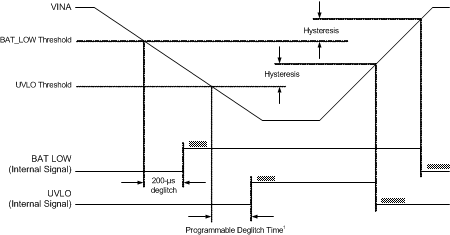DLPS043B June 2014 – February 2018 DLPA2000
PRODUCTION DATA.
- 1 Features
- 2 Applications
- 3 Description
- 4 Revision History
- 5 Pin Configuration and Functions
- 6 Specifications
-
7 Detailed Description
- 7.1 Overview
- 7.2 Functional Block Diagram
- 7.3
Feature Description
- 7.3.1 DMD Regulators
- 7.3.2 RGB Strobe Decoder
- 7.3.3 LED Current Control
- 7.3.4 Calculating Inductor Peak Current
- 7.3.5 LED Current Accuracy
- 7.3.6 Transient Current Limiting
- 7.3.7 1.1-V Regulator (Buck Converter)
- 7.3.8 Motor Driver
- 7.3.9 Measurement System
- 7.3.10
Protection Circuits
- 7.3.10.1 Thermal Warning (HOT) and Thermal Shutdown (TSD)
- 7.3.10.2 Low Battery Warning (BAT_LOW) and Undervoltage Lockout (UVLO)
- 7.3.10.3 DMD Regulator Fault (DMD_FLT)
- 7.3.10.4 V6V Power-Good (V6V_PGF) Fault
- 7.3.10.5 VLED Overvoltage (VLED_OVP) Fault
- 7.3.10.6 VLED Power Save Mode
- 7.3.10.7 V1V8 PG Failure
- 7.3.10.8 Interrupt Pin (INTZ)
- 7.3.10.9 SPI
- 7.3.11 Password Protected Registers
- 7.4 Device Functional Modes
- 7.5
Register Maps
- Table 7. Register Description
- 7.5.1 Chip Revision Register
- 7.5.2 Enable Register
- 7.5.3 Transient-Current Limit Settings
- 7.5.4 Regulation Current MSB, SW4
- 7.5.5 Regulation Current LSB, SW4
- 7.5.6 Regulation Current MSB, SW5
- 7.5.7 Regulation Current LSB, SW5
- 7.5.8 Regulation Current MSB, SW6
- 7.5.9 Regulation Current LSB, SW6
- 7.5.10 Switch On/Off Control (Direct Mode)
- 7.5.11 AFE (MUX) Control
- 7.5.12 Break Before Make (BBM) Timing
- 7.5.13 Interrupt Register
- 7.5.14 Interrupt Mask Register
- 7.5.15 Timing Register VOFS, VBIAS, VRST, and RESETZ
- 7.5.16 Motor Control Register
- 7.5.17 Password Register
- 7.5.18 System Configuration Register
- 7.5.19 User EEPROM, BYTE0
- 7.5.20 User EEPROM, BYTE1
- 7.5.21 User EEPROM, BYTE2
- 7.5.22 User EEPROM, BYTE3
- 7.5.23 User EEPROM, BYTE4
- 7.5.24 User EEPROM, BYTE5
- 7.5.25 User EEPROM, BYTE6
- 7.5.26 User EEPROM, BYTE7
- 8 Application and Implementation
- 9 Power Supply Recommendations
- 10Layout
- 11Device and Documentation Support
- 12Mechanical, Packaging, and Orderable Information
Package Options
Mechanical Data (Package|Pins)
- YFF|56
Thermal pad, mechanical data (Package|Pins)
Orderable Information
7.3.10.2 Low Battery Warning (BAT_LOW) and Undervoltage Lockout (UVLO)
If the battery voltage drops below the BAT_LOW threshold (typically 3.0 V) the BAT_LOW interrupt is issued, but normal operation continues. After the battery drops below the undervoltage threshold which has a default hardcoded value of 2.3 V (this UVLO voltage can be changed through register 09h from 2.3 V to 4.5 V), the UVLO interrupt is issued, all rails are powered down in sequence, the DMD_EN bit is reset, and the part enters STANDBY mode. The power rails cannot be re-enabled before the input voltage recovers to >2.4 V. To re-enable the rails, the PROJ_ON pin must be toggled. The undervoltage threshold is programmable from 2.3 V to 4.5 V in 31 steps.
The UVLO shutdown process will protect the DMD by allowing time for the mirrors to park, then doing a fast discharge of VOFS, VRST, and VBIAS. This protection occurs even in the case of sudden battery removal from the projector, as long as the bulk capacitance on the battery voltage (VINx) keeps this voltage above 2.3 V for as long as needed for VOFS, VRST, and VBIAS to discharge to the required safe levels as shown in the DMD data sheet. VOFS, VRST, and VBIAS discharge times depend on the load capacitance on each regulator. When for instance every supply is decoupled using a capacitor of 0.5 µF, VINx should stay above 2.3 V for at least 100 µs after the battery is suddenly removed. During this time, the mirrors can be placed in a safe position and VOFS, VRST, and VBIAS can be discharged.
NOTE
As required by the DMD data sheet, LS_OUT must stay above 1.65 V until VOFS, VRST, and VBIAS have discharged to their required safe levels.
